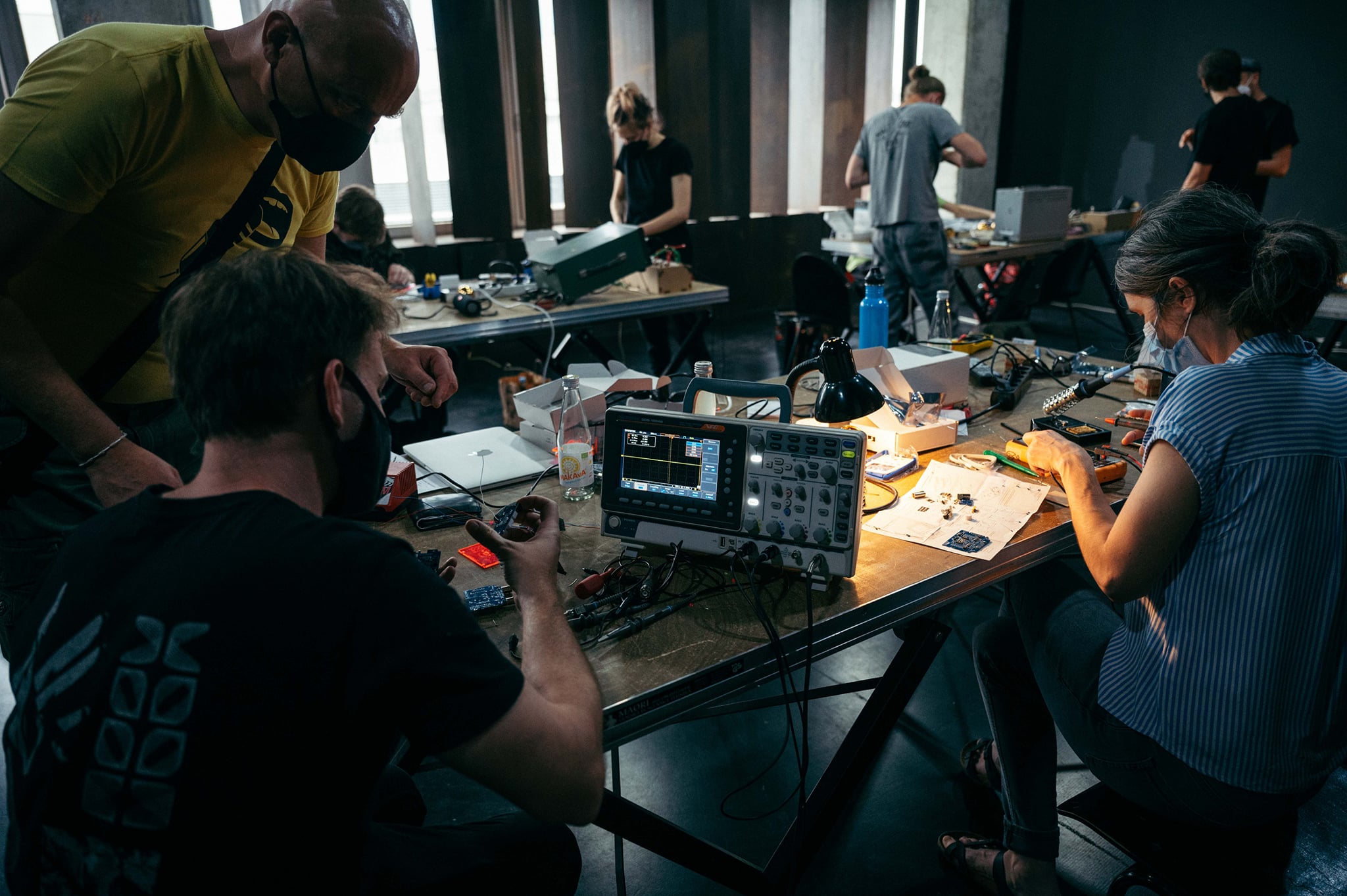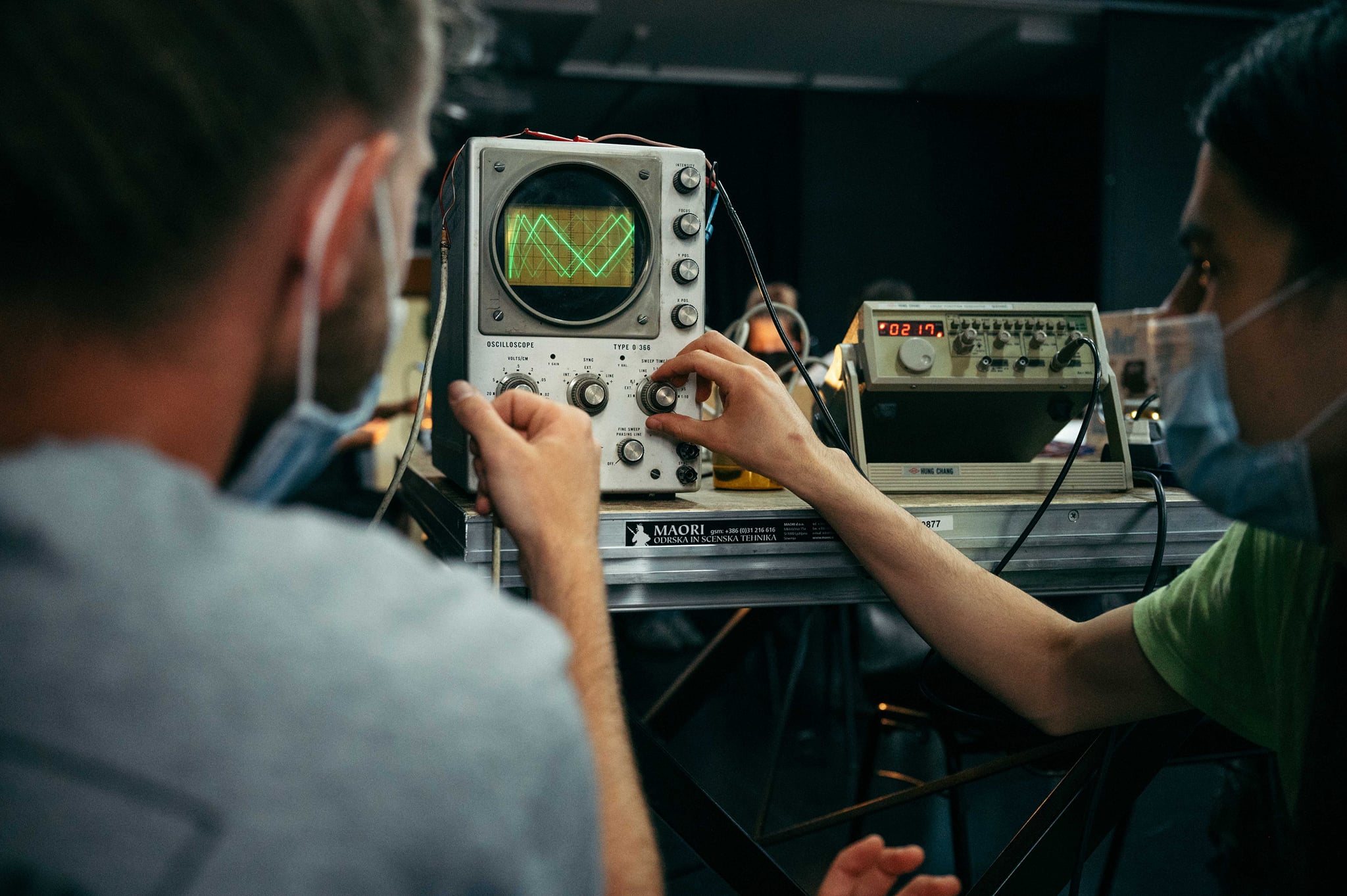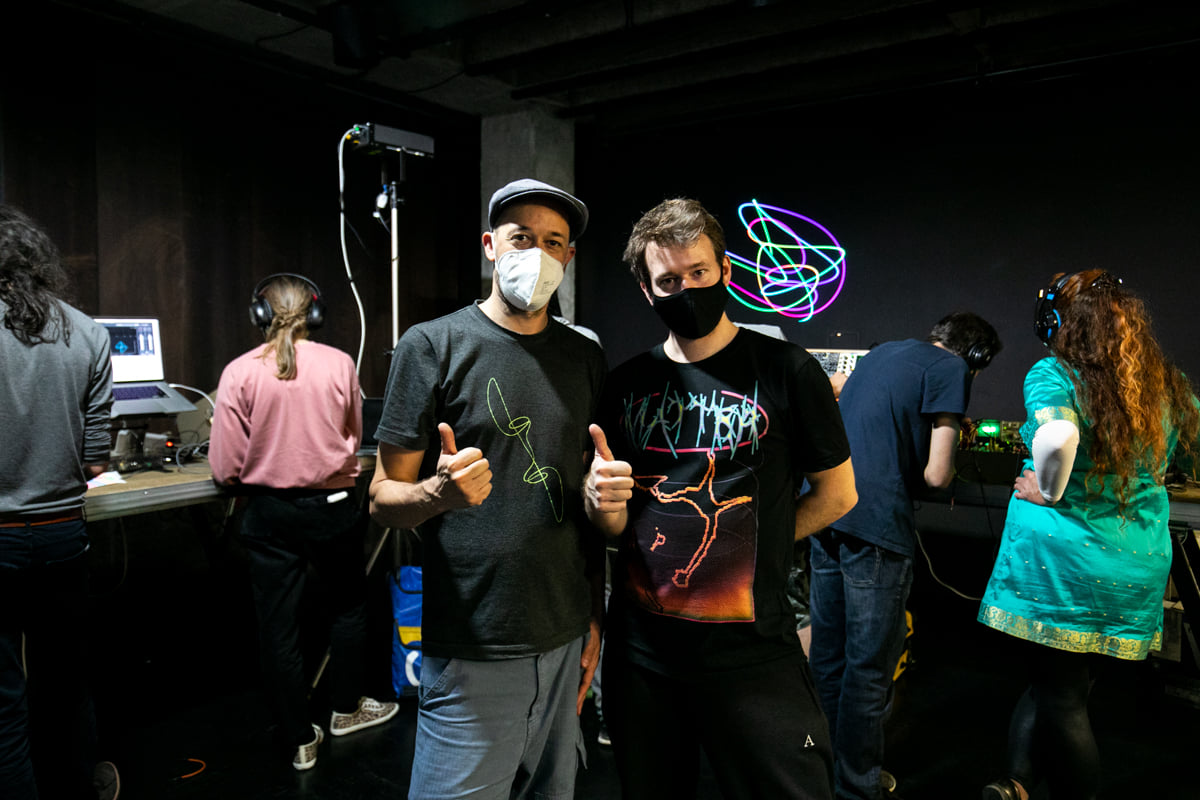How to draw with sound, opening-up the creative usage of laser projections
Published 20 October 2021 by Ewen Chardronnet
Build a DIY laser projector and learn how to make vector images with synthesizers! On October 4, Projekt Atol was hosting a Modul@rnice workshop by Bernhard Rasinger (New Jörg) and Václav Peloušek (Bastl Instruments) in Ljubljana. Makery discussed their MakersXchange project with Tina Dolinšek (Projekt Atol) and Václav Peloušek.
Václav Peloušek is a musician, educator, artist, founder and lead designer of the synthesizer company Bastl Instruments based in Brno, Czech Republic. Tina Dolinšek is a Ljubljana based new-media art producer, curator and cultural facilitator. Together they were selected for the summer second round of Hyper Global / Hyper Local exchanges of the European Union MakersXchange pilot program. Makery visited them in Ljubljana.
Makery: Can you tell us a bit of the context of the project you’ve been working on together here and that you presented at MakersXchange program ?
Tina Dolinšek: We’ve been working with Bernhard Rasinger & Václav Peloušek for the whole year as part of Modul@rnice, a workshops series dedicated to vector and modular synthesis. With the ongoing series we are trying to build a community around this topic and start a space for knowledge, skills and ideas exchange. In the previous years we were focussing individually on vector synthesis, followed by modular synthesis, and this year we’re combining them and trying to implement them in a more artistic approach. So 2021 started with an online lecture, afterwards we hosted an oscilloscope building workshop and for the grand finale Bernhard and Václav decided they wanted to develop a DIY laser projector. The idea seemed like a good opportunity to apply for the MAX program for two reasons. Firstly, we wanted to develop and support our own workshops (as opposed to just hosting them) to enrich our community here in Ljubljana, and secondly we wanted to connect our two educational platforms and communities – Modul@rnice and PIFcamp, a hacking summer that happened in August for the seventh time and it’s a great place to develop a project, test it and get direct feedback from the community.
Modul@rnice lecture by Bernhard Rasinger & Václav Peloušek:
Can you explain the project as if we were beginners in this field?
Václav Peloušek: Basically what we are doing is that we’re trying to draw shapes with sound. We use synthesizers, modular synthesizers, to create waveforms that get visualized and displayed in a 2D shape, on XY coordinates. There are several ways you can do that. The most common would be doing that with an oscilloscope, where you’re deflecting electron beams, so you can draw the shape on a fluorescent background. We did this in the context of a streamed lecture. We showed the basics of which modules or building blocks of modular synthesis you can use to draw shapes, because synthesizers are not necessarily designed to do this specifically, they are designed with the sound in mind. But you can use them in a different way, approach them from a different angle – to draw shapes in a visual way. So that was the first lecture we did online.
The lecture was followed by a hands-on workshop about building an oscilloscope. People could just come, build it and have a display device at home. The older oscilloscope we are using is the CRT oscilloscope. It is an obsolete piece of lab equipment, you can get it on a second hand market, but it’s not that easy to maintain. So we were building a cheap DIY kit of digital oscilloscope that we found on a Chinese website instead. We hacked it and converted it into a Eurorack module that can easily become a part of your synthesizer system. Because it is a measuring device, it doesn’t really have the same connectivity as the synthesisers, so we added the right connectors – jacks, a customised front panel and also appropriate power solution. After participants built it, we had experimental sessions where people played with it and we showed them some tricks on how to do it.


It is also nice to mention that Bernhard and I have these audiovisual projects called LaserMedusa and LaserBros, where we use professional laser projectors that Bernhard owns in combination with modular synths. We focus on a 30 minutes performance with intense sound drawn visuals, hearing the visuals where the drawings are generated by the sound, and hearing the XY coordinates that draw the shapes. This is one of the ways that you take the fun stuff you do and can perform it for the audience. But it is relatively hard to do it, because lasers are relatively dangerous and you need to be certified to operate them, and Bernhard is, but it is still hard to do it for anyone so we decided that we should make a simple version of a laser projector, which we then developed it at PIFcamp. We used a pair of speakers and attached mirrors to them, and tried different ways to attach the mirrors. One mirror would deflect the laser beam in the horizontal axis and one mirror in the vertical. So we developed this set up, it is really easy to do, you just need a pair of speakers, laser pointers, mirrors, double-sided tapes to hold it together, and it is really an easy thing you can build tomorrow in Indonesia. So we’ve been developing and playing with different ways to make it very simple, so anybody can do it. And what we really focused on was the documentation, a thorough piece of information on how to do it yourself.
Workshop at PIFcamp:
You recently had a workshop at osmo/za, can you tell us how did it go?
Tina Dolinšek: The workshop was a good mixture of hands-on approach, show and tell and improvisation/experimentation. Václav and Bernhard prepared the venue so it looked like a playground – there were 5 set-ups of different audiovisual combinations for participants to try out, for example vectrex, laser set-up and oscilloscope, all connected to a different modular synth. The workshop started with the hands-on making of the DIY laser projector, that made the experimental session which followed way more approachable and understandable. We also had a “round table” at the end where we collected feedback from the participants and we were surprised how good their observations were, knowing that more than half were complete beginners.
You can get the documentation poster of how to make the DIY laser projector at home here (it was designed by Jure Šajn).
What are you aiming at with this project?
Václav Peloušek: What we’re trying to do is to demystify a laser projector set-up or oscilloscope. They may both look very like science equipment with dangerous stickers on them, “dangerous device”, “do not use incorrectly”, etc. So we just built it in a very transparent manner, you see what is happening, how the mirrors are moving, etc. Maybe the angles are not that big so you don’t have a huge projection, but maybe that’s something we can improve. But I think the proof of concept was fulfilled.
At the beginning we thought we would focus on a DIY kit, but now we think we just want people to be able to do it anywhere in the world, with materials that are really easy to source. So anyone could just walk into a store and get all the parts, or even people already have a laser pointer at home, or pieces of mirrors. So we thought it’s more responsible to not produce a specialized kit, but create an instruction set with the things that you find at home, something that is more sustainable and transferable.
Tina Dolinšek: The building process is indeed really simple! You attach a small mirror on a speaker cone, point the laser on the mirror and you play some sound. The speaker starts to vibrate and the laser makes vector shapes, similar to Lissajous figures. At first we wanted to make a kit, but since you can find these materials at home or at your local makerspace, we thought of reusing instead of producing more waste. It’s true that kits are nice and convenient, but I think the responsible thing to do is always reuse when possible.
Václav Peloušek: If you look from an ontological perspective of what we’re doing, we had a set of speakers and a laser projector, and although they were exactly operating with the same signals, they still were two different devices that were just connected with a wire. So the processes of displaying the visuals and playing the sounds are separated. Using speakers to actually deflect the laser is really interesting because it becomes the same thing in the physical space. It’s not just a translation, a visualisation or a sonification, it doesn’t really matter how you look at it anymore, it is the same thing happening at the same time, which I think is really important because it was something hard to explain with our performances. People were asking “are you visualising the sound?” or “are you sonifying the visuals?” and it’s neither of those, you actually do it at the same time.
It’s the physicality of the experience that matters…
Václav Peloušek: Exactly. We also developed the modular patch to manage the signal that we play into the system. You do it together, you distinguish, and so when you perform you need to be respectful for both sound and the visual. You can’t really do classical beats of electronic music because it’s too fast and it’s then too much for the eyes, you would get tired very quickly. So the stuff that works best is a slow moving bass or drone, when you can actually enjoy the relationship between what your senses are giving you.
Tina Dolinšek: What Václav just described also sums up very well what we were doing the whole year. It’s about drawing with sound, but also vice-versa.

How come you started this long term collaboration together?
Václav Peloušek: Tina Dolinšek invited Bernhard and me to play for the first time in Ljubljana for the Strictly Analog festival in 2017 and then we attended several PIFcamps and Bernhard was always bringing laser projectors, so we’ve been trying many different ideas and the response was very positive and that’s also probably what triggered Tina to make this workshop series.
Tina Dolinšek: Huge inspiration for me to start with the Modul@rnice series was also a festival about vector synthesis Vector Hack we hosted in 2018 together with Ljudmila Lab. It was the first time ever that artists from this field gathered together and met in person – Ivan Marušić Klif and Derek Holzer initiated it, happening both in Zagreb and here in osmo/za. That was actually for me the first time I got interested in this kind of art form and wanted to continue with this topic as part of Projekt Atol education & art programmes. The problem was we didn’t have a community at that time, only scattered people who have modular synths or lets say they were interested in them, but no community and so no people to share skills and knowledge with others. Bastl Instruments in Brno has a strong community for instance.
Later on I was also influenced by the Synth Library Prague, who offers a safe space for sharing and learning about electronic music and modular synthesis. And next year we will try to establish a synth library in osmo/za, Ljubljana also.
What is your experience with the MakersXchange program?
Tina Dolinšek: It was a good opportunity to do something new and gain extra funding to develop a new workshop; and also to connect with other makers who were part of the program. Nevertheless, I think the whole reporting process was a bit too rigid, for these kind of small funds a flat fee or a stipend would work better.
More on MakersXchange.
